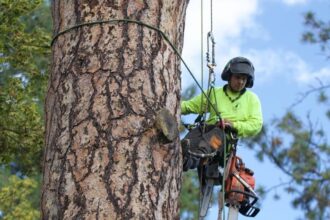Security requirements are a top priority for every construction project manager. Construction sites with expensive materials, equipment, and tools become vulnerable to theft, vandalism, and unsafe incidents. Construction site security strategies have the dual benefits of preventing construction site problems and maintaining workflow continuity. This article presents vital methods to protect your construction site and safeguard all your valuable assets.
Understanding the Importance of Construction Site Security
Construction sites are valuable because they contain many high-value materials and equipment, which attract criminal attention. Substantial risks include machinery theft and deliberate property damage. Building construction site security has become an essential requirement for all sites. Implementing effective security systems delivers dual advantages by reducing work-related medical incidents and keeping the project timetable intact without additional delays.
Direct actions aimed at site security protection provide investment safeguards, accident-free work environments, and operational continuity for contractors.
Key Elements of Construction Site Security
1. Perimeter Fencing and Barriers
Physical perimeter fencing with clearly defined boundaries needs to be implemented to initiate security measures for the construction site. Barrier fencing maintains site entry restrictions and prevents potential criminal attempts to access the site. The site must be enclosed by top-quality fencing along its perimeter, including secure gate locking systems after regular hours. Simple site access control through this method represents one of the most successful ways to secure facilities.
2. Surveillance Cameras
Construction sites benefit from surveillance cameras as they protect their facilities throughout operational times. Security cameras positioned well throughout the area reveal suspicious things while acting as warning signs and providing evidence for later use. Modern monitoring platforms allow site managers to observe operational activities no matter where they are located. Additionally, cameras with motion sensors trigger alerts for quick responses to potential threats.
3. Security Personnel
Cameras provide strong security solutions, yet on-site security staff create an additional defence network. Security guards perform site surveys to evaluate vulnerabilities before quickly responding to security breaches or emergencies. For sites of different sizes, security personnel should monitor important access points throughout the night to secure the site.
4. Lighting and Visibility
Construction sites need suitable lighting because unlit areas are harbours for criminal activities. Security and the safety of employees improve when facilities install illumination at entry points along with the areas designated for walking and high-value targets. Forces activation of motion-sensing lights that activate when movement occurs and simultaneously warn security of suspicious movements in the area.
Implementing Access Control Measures
1. Entry/Exit Logs and Identification Badges
Entry/exit logs enable facilities to document allowed personnel while recognising security risks. Employees and visitors must receive ID badges to help distinguish authorised from unauthorised persons. Regular sign-in and sign-out procedures correctly identify all persons accessing the area.
2. Controlled Access Points
Reinforcing site security requires prohibiting entry to designated vulnerable areas that contain valuables and vital construction worksites. Access to restricted areas should be controlled by locking gates, security doors, and turnstiles. The selected regions require approval for entry by authorised personnel, who must always accompany trusted supervisors and managers. Installing controlled access points enables site security because they allow entry only to authorised personnel with legitimate work purposes.
Protecting Equipment and Materials
1. Locking Up Valuable Assets
Theft is a significant risk in construction sites because aggressive thieves target valuable equipment, tools, and materials. Equipment and machinery must be locked each time personnel stop using them. The risk of equipment theft decreases with high-quality locks, while tools should be placed in specific storage containers or units. Equipment with tracking capabilities should be selected because it enables easy tracing when it is stolen.
2. Inventory Management Systems
A precise check-in and check-out system for site materials and tools, as well as project oversight, are fundamental for site security. A regular inventory check allows immediate identification of any missing items. Using unique identifiers on items allows tracing them in theft cases because they can be easily identified through barcodes or other identifiers.
Enhancing Security with Technology
Advanced technology solutions brought by modern times transform construction site security into more secure and efficient systems that protect project assets. The following technology solutions should be used with surveillance cameras and alarms for security enhancement.
1. Drones for Site Surveillance
Construction industry sites are becoming more regularly observed by drones as these flying machines become popular for site surveillance. The aerial devices grant security staff complete aerial oversight of the site to monitor its entire area. Using drones delivers quick and efficient area scanning, providing instant visual feedback to make immediate responses to security breaches possible.
2. Smart Alarms and Motion Sensors
Constructing your security system with smart alarms containing motion sensors will help your team react faster to security incidents on the construction site. The devices monitor site activity at night through their motion detection capability, which sends alert signals directly to security members. Intelligent systems can be linked to mobile devices through which construction managers always receive notifications.
Construction Site Security and Employee Safety
Security at construction sites accomplishes two purposes: it stops vandalism or theft activities and establishes safe working spaces for staff members. Every employee at the construction site requires training, including security protocols, emergency preparedness strategies, and procedures for reporting suspicious incidents. All personnel working in construction sites receive emergency readiness through accessible communication systems, including site-wide alerts and direct connections to security staff.
Conclusion
Any construction project needs security measures throughout its development period. Proper security measures involving surveillance systems paired with secure fencing and controlled access points help protect both workers and assets. Your combination of technology with personnel will establish theft prevention systems and reduce disruptions while building a protective workplace environment. Security measures protect your financial investments and lead to uninterrupted project advancement. Site security is fundamental for reaching project objectives while reducing risks and delays. Such spending yields lasting benefits for operations.

















